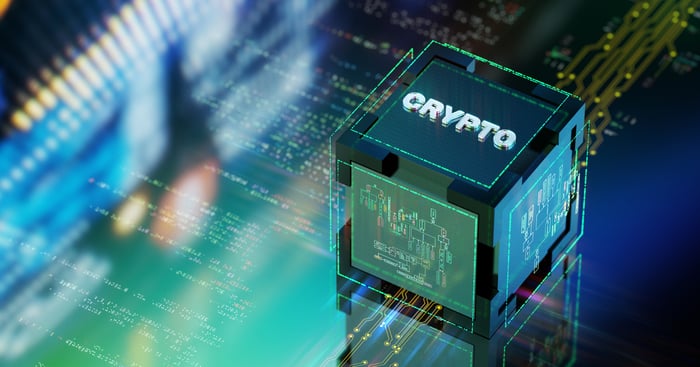Should You Buy XRP While It's Under $100?

Key Points
Ripple's digital currency has long struggled to gain mainstream adoption.
Regulatory conditions for cryptocurrencies have dramatically improved during the past 12 months.
The value of XRP (CRYPTO: XRP) is rising fast. This year, its value is up almost 30%. Last year, its value nearly tripled.
Right now, the cryptocurrency developed by Ripple Labs trades at about $3. But some crypto influencers have speculated that the price of XRP could eventually rise to $100. That would turn a $3,000 investment into more than $100,000.
Where to invest $1,000 right now? Our analyst team just revealed what they believe are the 10 best stocks to buy right now. Continue »
So should you buy XRP at its current level? There are two critical factors to pay attention to before you jump in.
Adoption of XRP could begin to rise rapidly
Although XRP has a bona fide use case in terms of cross-border monetary transfers by institutions, its value, like those of many meme coins, can swing dramatically in both directions. The crypto market may be much more mature than it was a decade ago, but cryptos in general remain volatile. A given coin's wide swings in price can be attributed to anything from shifts in real-world adoption to sudden changes in market trends that have little to do with the project's underlying utility.
The price action for XRP during the past 12 months, however, can arguably be attributed to a rapid improvement in its fundamentals. Since Ripple launched it in 2012, XRP has been constantly plagued by reputational damage stemming from government investigations and regulatory scrutiny. Even as the project has gradually signed on new bank clients, these pressures have kept a lid on XRP's valuation. That's because Ripple Lab's ultimate vision is for the crypto to compete with reliable, established payment protocols like the SWIFT (Society for Worldwide Interbank Financial Telecommunication) network, which has been in use by banks for decades. A relatively young crypto-backed protocol with a tarnished reputation was hardly going to get mass acceptance from conventional financial institutions.
Last month, however, news broke of a change that could finally release Ripple from its reputational disadvantages. On Aug. 8, the Securities and Exchange Commission formally settled its lawsuit with Ripple, levying a fine of $125 million against it. Stuart Alderoty, Ripple's chief legal officer, said that the settlement marked the end of the case.
Put simply, the regulatory environment for crypto projects like XRP has improved dramatically during the past 12 months. Many in Congress would like to pass legislation that clarifies rules and regulations for the crypto industry, and helps it expand and innovate faster. The result could be what Ripple has long sought: mass adoption of crypto technologies and networks by traditional financial institutions.

Source: Getty Images
Ripple is chasing a $111 trillion opportunity
Now that Ripple has an opportunity to scale up the adoption of its network faster and to a greater magnitude than ever before, it's important for investors to realize just how large an opportunity it is targeting. Its network has the potential to supplant many long-standing payment networks. Its biggest target by far is the SWIFT network. That payment protocol, used by big banks around the world, handles roughly $111 trillion in transaction volume every three days. Compare that to XRP's $180 billion value and you quickly get a sense for how large the project could become if mass crypto adoption becomes a reality.
Here's the catch: It will take XRP a long time to reach those volumes -- assuming it ever becomes as large as the SWIFT network. Today, the SWIFT network accounts for half of all high-value cross-border payments. But it took nearly 50 years to get to this point. SWIFT was created in 1973, but it took four years before the first transaction message was sent. It took another two years for the first non-European message to be processed. In those years, SWIFT was supported by just a couple hundred banks versus the 11,000 financial institutions that use its network regularly today.
The point here is that, yes, XRP's theoretical value is significantly higher than its current trading price. Plus, the regulatory environment and potential adoption runway have improved considerably during the past year. But XRP remains a long-term story, even if its trading price reacts dramatically in the short term. Investors who add the crypto to their holdings should maintain a multidecade time horizon, even if the sudden gains during the past year suggest that there's fast money to be made.
Should you invest $1,000 in XRP right now?
Before you buy stock in XRP, consider this:
The Motley Fool Stock Advisor analyst team just identified what they believe are the 10 best stocks for investors to buy now… and XRP wasn’t one of them. The 10 stocks that made the cut could produce monster returns in the coming years.
Consider when Netflix made this list on December 17, 2004... if you invested $1,000 at the time of our recommendation, you’d have $672,879!* Or when Nvidia made this list on April 15, 2005... if you invested $1,000 at the time of our recommendation, you’d have $1,086,947!*
Now, it’s worth noting Stock Advisor’s total average return is 1,066% — a market-crushing outperformance compared to 186% for the S&P 500. Don’t miss out on the latest top 10 list, available when you join Stock Advisor.
*Stock Advisor returns as of September 8, 2025
Ryan Vanzo has no position in any of the stocks mentioned. The Motley Fool has positions in and recommends XRP. The Motley Fool has a disclosure policy.





